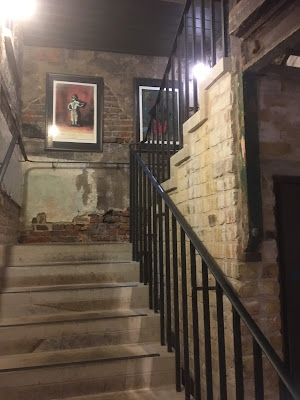Wiltons Music Hall is truly a hidden gem in the east end located in Graces Alley Whitechapel London and it is well worth a visit. You can take a tour with a guide around the building which is packed with useful interesting information about the music hall and surrounding area and lasts approximately for one hour.
Whilst waiting before the tour begins I would recommend visiting the history room which is very insightful, but doesn’t give any spoilers.
I’m going to give some insight of the history of Wiltons music hall now.
Originally an alehouse dating from 1743 or earlier,
Wilton's is a unique building comprising a mid-19th Century grand music hall attached to an 18th-century terrace of three houses and a pub.
1826, it was also known as The Mahogany Bar, reputedly because the landlord was the first to install a mahogany bar and fittings in his pub. In 1839 a concert room was built behind the pub and in 1843 it was licensed for a short time as The Albion Saloon, a saloon theatre, legally permitted to put on full-length plays. John Wilton bought the business in c. 1850, enlarged the concert room three years later, and replaced it with his 'Magnificent New Music Hall' in 1859.
Wiltons was built on the same site as the former concert room of the Albion Saloon. Wilton furnished the hall with mirrors, chandeliers and decorative paintwork, and installed the finest heating, lighting and ventilation systems of the day. In the theatre, a single gallery, on three sides and supported by 'barley sugar' cast iron pillars, rises above a large rectangular hall and a high stage with an arch. In its heyday, a 'sun-burner' chandelier of 300 gas jets and 27,000 cut crystals, illuminated a mirrored hall.
In the thirty years Wilton's was a music hall, many of the best-remembered acts of early popular entertainment performed here, from George Ware who wrote 'The Boy I love is up in the Gallery', to Arthur Lloyd and George Leybourne known as Champagne Charlie.
Wiltons was destroyed by fire in 1877 however it was during the 1870s that the music hall had several ownerships and an eight year rebuild was but in place the building was bought by the Methodist Church East End Mission.
During the Great Dock strike of 1889, a soup kitchen was set up at The Mahogany Bar, feeding a thousand meals a day to the dockers families. The Mission remained open for nearly 70 years, through some of the most testing periods in East End history including the 1936 Mosley March and during the London Blitz of World War II.
During the 1950s the church ceased and the hall was used for rag storage as a warehouse. During the 1960s the London county council put in for compulsory purchase for slum clearance whereby Wiltons was scheduled for demolition.
However a campaign was started to save Wiltons and all its glorious history and in 1971 was awarded with grade II listed status and today is now recognised as not only a music hall but a heritage site.
Frances Mayhew, former Managing and Artistic Director took over the building in 2004, It was again derelict from the late 1990’s and in debt. In June 2007 the World Monuments Fund added the building to its list of the world's "100 most endangered sites".
Over the next decade Frances Mayhew and her team restored the building with a programme of arts and community activities and the reinstatement of The Mahogany Bar. The profile grew and in 2012, thanks to donations.
Enough money was raised to carry out the first half of a Capital Project to repair the building.
This first half repaired the auditorium and in 2013, with support of Heritage Lottery Fund and other donors, Wilton’s was able to raise the £2.6 million needed to begin part two of the project to repair the houses, numbers 1 to 4 Graces Alley and 17 Wellclose Square, which make up Wilton’s front of house. This included creating a new Learning and Participation Studio funded by the Aldgate and Allhallows Foundation. The project was completed in September 2015 leaving the building structurally secure – probably for the first time since the renovations of music hall days.
It’s thanks to these campaigns and restorations that a piece of London Music hall history is ours still to treasure today.
Mahogany Bar
Wilton Staircase
Inside Wiltons
Foundation stone
John Wilton
Wiltons Music Hall
Wiltons Music Hall








No comments:
Post a Comment
Note: only a member of this blog may post a comment.